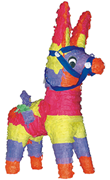 |
Marco Polo discovered the Chinese fashioning figures of cows, oxen or even buffaloes, covering them with colored paper and adorning them with harnesses and trappings to greet the New Year. When they knocked the figure hard with sticks of various colors, seeds spilled forth. The remains were then burned and people gathered the ashes to bring good luck throughout the year. |
When the custom passed into Europe in the 14th century, it was adapted to the celebration of Lent. The first Sunday became 'Piñata Sunday'. The Italian word 'pignatta' means "fragile pot." Originally, piñatas resembled clay containers used for carrying water. Some believe this is the origin of the traditional pineapple shape. However, the Latin prefix 'piña' also implies a cluster of flowers or fruits as in 'pineapples' and 'pine cones'.
The custom then spread to Spain, the first Sunday in Lent becoming a fiesta called the 'Dance of the Piñata'. The Spanish used a clay container called la olla, the Spanish word for pot. At first, the la olla was not decorated. Later, ribbons, tinsel and fringed paper were added and wrapped around the pot.
At the beginning of the 16th century the Spanish missionaries to North America used the piñata to attract converts to their ceremonies. However the indigenous peoples already had a similar tradition. To celebrate the birthday of the Aztec god of war, Huitzilopochtli, priests placed a clay pot on a pole in the temple at year's end. Colorful feathers adorned the richly decorated pot, filled with tiny treasures. When it was broken with a stick or club, the treasures fell to the feet of the god's image as an offering. The Mayans, great lovers of sport, also played a game where the player's eyes were covered while hitting a clay pot suspended by string. The missionaries ingeniously transformed these games for religious instruction. They covered the traditional pot with colored paper, giving it an extraordinary, perhaps fearful appearance.
The decorated clay pot also called a cantero represents Satan who often wears an attractive mask to attract humanity. The most traditional style piñata looks a bit like Sputnik, with seven points, each with streamers. These cones represent the seven deadly sins, pecados – greed, gluttony, sloth, pride, envy, wrath and lust. Beautiful and bright, the piñata tempted. Candies and fruits inside represented the cantaros (temptations)of wealth and earthly pleasures.
Thus, the piñata reflected three theological virtues in the catequismo. (religious instruction or catechism)
The blindfolded participant represents the leading force in defying evil, 'Fe', faith, which must be blind. People gathered near the player and spun him around to confuse his sense of space. Sometimes the turns numbered thirty three in memory of the life of Christ. The voices of others cry out guidance:
¡Más arriba! More upwards!
¡Abajo! Lower!
¡Enfrente! In front!
Some call out engaños (deceits, or false directions) to disorient the hitter.
Secondly the piñata served as a symbol of 'Esperanza', Hope.
With the piñata hanging above their heads, people watched towards los cielos (sky or heaven) yearning and waiting for the prize. The stick for breaking the piñata symbolized virtue, as only good can overcome evil. Once broken, the candies and fruits represented the just reward for keeping faith.
Finally the piñata symbolized 'Caridad', Charity. With its eventual breaking, everyone shared in the divine blessings and gifts.
The moral of the piñata: all are justified through faith.
Today, the piñata has lost its religious symbolism and most participate in the game solely for fun. Piñatas are especially popular during Las Posadas, traditional processions ringing in the Christmas season and at birthday parties. During festivities, people traditionally sing songs while breaking the piñatas.
“Dale, dale, dale, no perdas el tino,
porque si lo perdes, pierdes el camino.
Esta piñata es de muchas mañas, sólo contiene naranjas y cañas.”
“Hit, hit, hit. Don't lose your aim,
Because if you lose, you lose the road.
This piñata is much manna, only contains oranges and sugar cane.”
Piñatas can be found in all shapes and sizes. Modern ones often represent cartoon or other characters known to most children. Others are shaped like fruits, baskets, rockets etc. Sometimes people of political statue are satirized. At Christmas, star-shaped piñatas suggestive of the Star of Bethlehem are especially popular. One's imagination is the creative limit.
Traditionally, piñatas are filled with both candies and fruits. Around Christmas in Mexico, wrapped candies, peanuts, guavas, oranges, jicamas, (sweet root vegetable) sugar cane, and tejocotes (a kind of crab apple) stuff piñatas. Some types of piñatas called traps, are stuffed with flour, confetti or 'flowery water'. Any child without a treat after the goodies are gathered from the ground is given a little basket full of special candy. These colaciónes are kept on hand to avoid hurt feelings and tears. The rest of the treats are passed around to everyone before the party is over



















